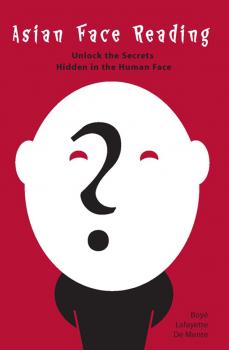Boye Lafayette De Mente
Список книг автора Boye Lafayette De MenteInstant Chinese
It's amazing how 100 key words and phrases provide instant communication! Do you want to speak simple Mandarin Chinese but are too busy to study it? Are you visiting China for a short time and want a Mandarin phrase book to help you communicate in the Chinese language? If so, this Mandarin phrasebook and dictionary is for you. It's tiny 0.4 x 4.1 x 5.9 inches size makes it incredibly convenient to travel with but without losing the most essential content for communication. This new, expanded edition contains 15% more content, fun manga-style illustrations, and additional information on which destinations, personalities and trends are hot in China right now!The idea of Instant Chinese is simple—learn 100 words and phrases and say 1,000 things. The trick is knowing which 100 words to learn, but the author Boye Lafayette De Mente has solved the problem, choosing only those words you'll hear again and again. Even with a vocabulary this small, you'll be surprised how quickly and fluently you too can communicate in Mandarin Chinese. Words are repeated in different combinations, building familiarity without effort. All phrases are given in both simplified Chinese characters and standard Hanoi Pinyin romanization. A brief guide to pronunciation allows the user to say the phrases correctly. An English–Chinese dictionary makes looking up a word or phrase simple and quick. Here's a sample of what you'll be able to do with this chinese phasebook: Meet people. Go shopping. Ask directions. Ride the subway. Order food and drinks. And much more.
Survival Japanese
A handy Japanese phrasebook and guide to the Japanese language, Survival Japanese contains basic vocabulary necessary for travelling in Japan. This book contains all the necessary words and phrases for speaking Japanese in any kind of setting. Perfect for students, tourists, or business people learning Japanese or travelling to Japan, it also contains a beginner guide to the Japanese language, allowing for a deeper understanding of Japanese than a typical Japanese phrasebook or Japanese dictionary. The phrase book is broken into two basic sections: Common Japanese Expressions and Key Words, and Japanese Pronunciation Guides for Key Japanese Names and Signs. All Japanese words and phrases are written in Romanized form as well phonetically, making pronouncing Japanese a breeze. For example, the word for «hotel», hoteru is also written as hoe-tay-rue . Authentic Japanese script ( Kanji and Kana ) is also included so that in the case of difficulties the book can be shown to the person the user is trying to communicate with. Key features of Survival Japanese include: Hundreds of useful Japanese words and expressions. A short Japanese dictionary in the back Up-to-date expressions for the internet, mobile, and social media Romanized forms, phonetic spellings, and Japanese script ( Kanji and Kana ) for all words and phrases. Tone markings indicated for all words and phrases A concise background and history of the Japanese language. A pronunciation guide for Japanese words including long vowels, double consonants, and accents. A guide to Japanese grammar including word order, questions, singular vs. plural, and formal, vs. informal.
The Korean Mind
The Koreans: understanding a people and their culture through key words and language. Koreans have a unique character and personality that sets them apart from all other Asians. And although Korean attitudes and behavior may be influenced by the modern world, the Korean mindset is still very much shaped by ancient culture and traditions. As is the case with all ancient cultures created within highly refined and meticulously structured social systems over thousands of years, one of the keys to understanding traditional Korean attitudes and behavior is the language of the people—or more precisely, key words in the language. These key words provide access to the Korean mind—to core concepts and emotions, the attitudes and feelings that make up the Korean psyche. These key terms reveal both the heart and soul of Koreans and provide bridges for communicating and interacting with Koreans on the most fundamental level.In The Korean Mind , Boye Lafayette De Mente explores the meanings and cultural context of the most important «code words» of the Korean language, terms whose significance goes well beyond their literal definitions, providing an insight into Korean culture and the personality of the Korean people. Keywords include: Aboji, Ah-boh-jee — The «Father Culture»Anae, Ah-negh — Wives: The Inside PeopleHan Yak, Hahn Yahk — The Herbal Way to HealthInnae, Een-nay — A Culture of EnduringKatun Sosuy Pap, Kaht-unn Soh-suut Pahp — Eating from the Same Rice BowlAnd over 200 more…
Women of the Orient
From the hair color and style, body-type, shape to etiquette and level of femininity of Asian women, Boye de Mente takes the reader into full detail with Women of the Orient chapters including:The women of JapanThe women of KoreaThe women of Taiwan & Hong KongThe women of ThailandThe Women of VietnamAnd lastly the Women of the PhilippinesIn Women of the Orient, Boye De Mente, reveals Asia's exotic cities and explores the unique character and charms of some of the world's most feminine women. Learn how hot-tempered Korean girls keep warm on cold winter nights, what kind of hot dip is offered in Japan's so-called «Soaplands» and what goes on under the table in «Taiwan Roulette». All of this and more is discussed in a disarmingly frank manner, providing a host of insights for all girl watchers, apprentice and veteran alike.
Asian Face Reading
Imagine how much you could learn if you knew how to evaluate a person's character, health, fortune, social status, sexual charisma, and life expectancy from a careful reading of his or her face.Face reading, a practice as old as man, is a universal art that we all use every day—with varying degrees of skill. We all know and respond to facial expressions that indicate fear, anger, merriment, and other moods, and we know from experience that facial characteristics, such as unusually large eyes or big noses, have an important influence on our lives. In China and Japan, face reading is a respectable analytical tool used to make business decisions, arrange marriages, and evaluate partnerships and friendships.Asian Face Reading offers a quick, practical, easy-to-understand and easy-to-apply introduction to the basic principles of face reading. The book is fully illustrated with dozens of examples readers can use to learn this increasingly popular practice—and to analyze their friends, colleagues, and loved ones.
Etiquette Guide to Japan
Farewell to faux pas! Minding your manners is an acquired skill, but what serves you well elsewhere could trip you up in Japan. Save yourself possible embarrassment with Etiquette Guide to Japan . An inside look at Japanese social graces, it answers all the questions of the thoughtful traveler. Extensive, specific information on Japanese business etiquette assists readers traveling to Japan for business.Although often overshadowed by a modern facade, long–standing traditional aspects of Japan's culture still influence the country and almost everyone in it. Concrete evidence of this traditional culture can be seen everywhere—in the ancient arts and crafts that are still important parts of everyday life, in the many shrines and temples that dot the nation, and in the modern comeback of traditional fashions such as kimono and yakata robes. To many Western visitors, however, the most obvious example of this traditional culture's strength is the unique etiquette of the Japanese. Like many nations, Japan has experienced vast political, social, and economic change over the past century. But enough of Japan's traditional etiquette remains to set the Japanese apart socially and psychologically and to make success in socializing and doing business with them a special challenge for Westerners. About this new version: This updated and expanded edition of the best-selling Japanese etiquette guide addresses not just the puzzling protocols relating to name cards, bowing or shaking hands, bathrooms and public baths—but also what to do when entertaining Japanese dinner guests, attending a Japanese tea ceremony, taking the subway, and much more! It also provides the latest etiquette in mobile phone manners, texting, social media and other forms of digital communication. The glossary at the back of the book has been revised to include the latest technology-related words and expressions used by Japanese today. Two new chapters address the changing role of foreigners in the workplace and the contemporary business style and etiquette used by the younger generation of Japanese who are now increasingly cosmopolitan—but still very Japanese!
Business Guide to Japan
Conducting business in Japan: a delicate and valuable skill is explained by a true master of Japanese culture. Not only is Japan the world's third largest economy, it is a global center for design for non–Japanese businesses looking to expand into international markets.But business people from outside Japan quickly discover that doing business in Japan is unlike anything they've experienced before. They find Japanese business etiquette and culture both highly regimented and maddeningly impenetrable—making it difficult to identify, much less approach, key decision–makers, or to bring negotiations to a successful close.Japanologist Boye Lafayette De Mente explains the key aspects of Japanese business practices and protocols with specific advice for approaching and engaging with Japanese executives, their staffs, and their organizations. Business Guide to Japan offers yo invaluable insights into how to unravel the complicated maze of business bureaucracy, interpret verbal and written messages from your contacts, and create the critical social «comfort zone» necessary for working with Japanese companies. Doing business with the Japanese can be both challenging and rewarding, and the Business Guide to Japan offers you precise guidelines for success.






